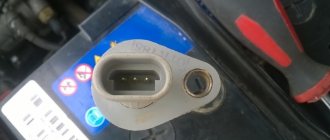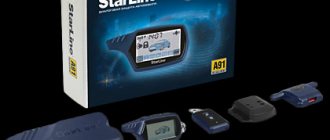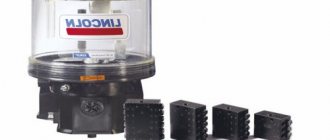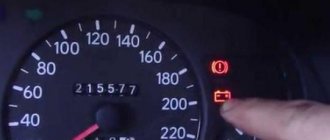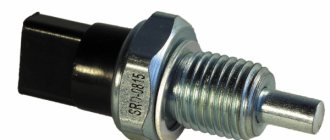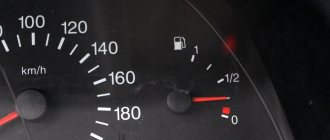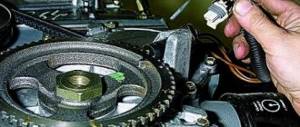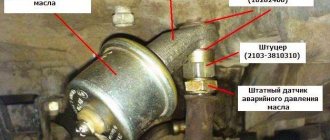Measuring the speed of a car has long been carried out non-mechanically. A speed sensor is responsible for this, the operating principle of which is based on the Hall effect. This sensor supplies the controller with electromagnetic pulses, on the basis of which the latter calculates the speed of the machine.
Vehicle speed is measured as follows. For each kilometer of distance traveled, the sensor sends a fixed number of pulses to the controller - 6004. The faster the car moves, the higher the transmission frequency. Thus, the controller calculates the speed based on the time interval between pulses.
In addition to its main function, this sensor indirectly helps the car owner save fuel. When the car is coasting at a speed of over 20 km/h, the controller, based on sensor readings, does not open the fuel supply.
The speed sensor of the VAZ 2114, like all other cars of the VAZ family, including the VAZ-2109, Kalina, Priora, is located on the gearbox, or rather, on the speedometer drive mechanism. To find it, you need to crawl under the hood; it is advisable to remove the adsorber to open up the space (you can do without removing it, but getting to the speed sensor will be more difficult). On the side of the right inner CV joint, you need to find the wire that goes to the gearbox; it is this that is connected to the speed sensor connector.
Signs of a malfunctioning speed sensor
If the speed sensor malfunctions, it becomes impossible to measure the speed of the car, but that's not all. The worse thing is that this causes interruptions in the operation of the motor. The most common signs that indicate a malfunction are the following, which can only be eliminated by replacing it:
- the speedometer does not work or gives incorrect readings;
- unstable idle;
- increased fuel consumption;
- the engine stops developing full power.
According to statistics, most often a malfunction is indicated by the engine stopping at idle, when the car is coasting, or when the driver presses the clutch to change gear. Typically, the Check engine indicator lights up on the instrument panel, and if the car is equipped with an on-board computer, it displays error code “24”.
If the speed sensor on the Kalina is faulty, the symptoms include inoperative electric power steering and increased sensitivity of the fuel gauge to the level of gasoline in the tank.
Video “Replacing the speed sensor”
This video demonstrates how to replace a speed sensor with your own hands (the author of the video is Alexandr V).
The speed sensor on cars of the VAZ and Kalina family is, in particular, designed to control the operation of the car at idle and, in cooperation with the idle speed controller, control the air flow that bypasses the throttle valve. If there is a malfunction or any malfunctions, the sensor transmits erroneous data, which can lead to incorrect operation of not only the engine itself, but also the entire system as a whole.
In the video, replacing and checking the speed sensor on a Lada Kalina:
Replacing the speed sensor Lada Kalina full review
Replacing the Lada Kalina speed sensor
full review The second part of the video where I forgot to say something.
Replacing the Lada Kalina speed sensor
Auto electronics store karkam Replacing the speed sensor Lada Kalina
. The cost of the sensor is approx...
If the car belongs to the category of modern, highly equipped, then the sensor failure will be indicated by error code No. 24 displayed on the on-board computer, or the Check engine light will come on. In relation to Kalina, if the device breaks down, the electric power steering also refuses to work.
As a rule, breakdowns in the sensor occur for several main reasons. For example, as a result of an electrical circuit failure. This is why it is so important to regularly monitor electronics, as the most vulnerable system of a car. If any contacts become oxidized or even just a little dirty, this can also have a very negative effect on the operation of electronic devices.
To fix the problem, in this case you just need to clean the contacts and coat them with any special lubricant for electrical wiring, which can be purchased at car dealerships. Their cost is low, so such prevention is affordable for every car owner.
Often, electrical wiring failure occurs in the exhaust manifold area. be checked , since it directly affects all other electronic systems. And the last thing is a defect in the speedometer cable. If there is even a tiny crack or even a burr on it, there is no doubt that the sensor will immediately fail.
If the sensor has completely failed, then it cannot be repaired, you can only replace it. Replacement is carried out quickly. And the price of the device is low: starting from a couple of hundred, depending on the manufacturer’s brand.
Causes of speed sensor malfunction
Most often, malfunctions occur when the electrical circuit is broken, so diagnostics should begin with checking the wires and contacts. Oxidized or dirty contacts must be cleaned and coated with some kind of lubricant, for example “Litol”.
A possible broken wire should be looked for near the connector. At this point they bend and often fray. You also need to check the integrity of the wire insulation in the exhaust manifold area. It can melt, after which a short circuit occurs.
The cause of a sensor malfunction may be a worn speedometer cable. Over time, breaks and burrs appear on it, which subsequently lead to the sensor failure.
Checking the induction DS
The signal that comes from the rotation of the wheels essentially resembles the oscillation of a wave impulse. Therefore, the voltage changes depending on the rotation speed. Everything happens in the same way as with the crankshaft angle sensor.
Subscribe
to our channel in
Index.Zen
Even more useful tips in a convenient format
If the sensor is working properly and the gear is not leaking, then there may be no power to the sensor or there is a break/short somewhere in its wiring. In addition, the ECU and ABS are involved in the readings on the tidy. The wire from the ECU to the instrument panel or from the ABS may have been lost (you should call the wire from the speedometer to the ABS block). It is possible that the device is faulty.
Good day everyone, I have such a problem that the speedometer and odometer do not work. My car is a Hyundai Santa Fe 2 2007. I checked the speed sensor drive gear, everything is ok, I don’t know how to ring or check the sensor itself. The workers checked the inductive sensors on the box by eliminating everything, the check light came on, I don’t know what else could be the reason, since you drive with a scanner, the speed shows “0” on the speedometer, maybe someone has someone who can tell me.
Guys, good afternoon everyone! Please tell me! I have a Lada 14 and just recently the speed began to fluctuate, it almost stalls, it does not work evenly. Diagnostics showed a camshaft sensor, they replaced the sensor with a new one, but there was no result. By the way, the speedometer and tachometer do not work. What could be the reason?
Thank you, detailed article!
And it will be even more clear how to check the speed sensor if you watch the video of the HF channel: https://youtu.be/qiDmZLUuTMI
Thank you for a very clear and accessible description of checking the speed sensor yourself. Thanks to the instructions, I was able to do it myself. It turned out to be really dying.
Good afternoon Subaru Outback has a 2007. The check lights up. The error code reveals P0500 – circuit speed sensor. But there are three sensors there. The question is how to determine which of them does not work? Or how else can I check?
The reason is not always only in the speed sensor (this behavior can also appear when the contacts in its connector oxidize), although if it starts to lie, then this is precisely the problem. Perhaps the problem lies in the device itself, then you have to disassemble it and check the arrow drive mechanism. On cars with a cable drive, such a malfunction is often hidden either in old oil on the gears, or in a worn square at the end of the cable, or the lubrication of that same cable helps.
Volkswagen Multivan T5 2012 car. Sometimes when accelerating the speed needle shakes/jerks. I looked for this sensor in ETKA and couldn’t find it. What could be the problem?
My Galant 8 (shark) has stopped showing the speedometer and the revs without load are developing well, only if you stick D in, the rev shows 2500 and there is no 3rd and 4th respectively. Automatic transmission box. Could it be the speed sensor? By the way, the speed sensor is some kind of magnetic.. I’m looking forward to the answer from the experts!
On my Toyota, the signal from the sensor first goes to the instrument panel, and from it to the signal converter for the ECU, and then to the ECU.
Useful article, but they lied a little at the beginning. It is written that the speed sensor sends its signals to another sensor - this is not true. All sensors first send their signals to the ECU, and it will decide what to do next based on all the data received from other sensors.
What numbers does the multimeter show when testing both sensors? It is quite possible that the sensor is not the right one. When purchasing a new sensor you really need to look at the part number! Despite their external similarity, Kalinovsky and Priorovsky sensors are not interchangeable. Since 2011, it seems that Prior sensors have been installed. And by the way, it is possible that the magnetized disk inside the box has come off its mounts (such cases also happen).
Kalina car is a 11 year old, the speedometer shows an underestimated speed. I can't find the reason. I removed the old speed sensor and replaced it with a new one, same picture. The gearbox is like the Priora. Maybe I installed the wrong sensor? The instruments are working, the arrows are all moving, I checked them. Tell me what to do, what to watch?
very interesting case! Have you asked our experts this question in the Q&A section? If not, then copy it and put it in that section!
How to check the speed sensor on a VAZ-2109
Checking the speed sensor begins by finding out whether 12 V is supplied to its contacts. Since its operating principle is based on the Hall effect, the contact through which the pulse signals pass can only be tested by torsion. The voltage varies in the range from 0.5 V to 10 V.
There are three ways to check the device; the first two require a multimeter.
First way
- the sensor is removed;
- using a multimeter you need to find out what each contact is responsible for, you need to find the pulse one;
- the positive probe is connected to the pulse contact, and the negative probe is connected to the car body or engine;
- A piece of tube is put on the sensor axis and rotates at a low speed, while the voltage is measured with a multimeter: the higher the rotation speed, the higher the pulse frequency and voltage.
Second method (without dismantling)
- use a jack to lift one of the front wheels of the car;
- the multimeter is connected to the sensor wires;
- you need to rotate the wheel and check whether pulses appear (if so, the device is working normally).
Third method (without a multimeter)
If a measuring device is not available, the test can be performed using a test lamp or a regular 12-volt light bulb. The procedure is similar to the second method.
- The pulse wire is disconnected from the sensor;
- with the ignition on, use a control lamp to find “plus” and “minus”;
- the wheel is hung out;
- the control lamp is connected to the signal wire, the wheel rotates (if the “minus” lights up on the control, the sensor is working).
If you don’t have a warning lamp at hand, you can use a 12-volt one (for example, from a turn signal). The wire connects the battery plus and the signal contact. If the sensor is operational, the light will blink.
If the check shows that the device is working properly, you need to check how its drive works. To do this, the front wheel is hung out. You need to find the sensor drive by touch. Then you need to rotate the wheel with your foot, and with your hand you need to check whether there is rotation in the drive and whether it is stable.
Checking the speed sensor
First you need to find out whether there is grounding and 12 V voltage in the contacts. These contacts are wired, and the contact with pulse signals is tested by torsion.
Method 1 (check with a voltmeter)
- We remove the speed sensor.
- We use a voltmeter. Let's find out which terminal is responsible for what. We connect the incoming contact of the voltmeter to the terminal that outputs pulse signals. We ground the second contact of the voltmeter to the engine or machine body.
- By rotating the speed sensor, we determine whether there are signals in the operating cycle and measure the output voltage of the sensor. To do this, you can put a piece of tube on the sensor axis (twist at a speed of 3-5 km/h). The faster you rotate the sensor, the higher the voltage and frequency in the voltmeter should be.
Method 2 (without removing from the car)
- Place the car on a jack so that one wheel does not touch the ground.
- We connect the contacts of the sensor with a voltmeter.
- We rotate the wheel and diagnose whether voltage appears - if there is voltage and frequency in Hz, then the speed sensor is working.
Method 3 (check with a control or light bulb)
- Disconnect the pulse wire from the sensor.
- Using the control, we look for “+” and “–” (after turning on the ignition ).
- We hang one wheel as in the previous method.
- We connect the control wire to the “Signal” wire and rotate the wheel with our hands. If “-” lights up on the control panel, then the speed sensor is working.
Checking the DS with a tester
Replacing the speed sensor on a VAZ-2109
A faulty speed sensor cannot be repaired. Replacement is quick and easy. To work you will need keys “10” and “21”. First of all, the battery is disconnected from the on-board network, then the speed sensor connector is disconnected.
After this, the sensor itself is unscrewed. If its rod breaks, you will have to dismantle the drive. This must be done carefully so as not to drop the broken rod inside the gearbox.
Installation is carried out in reverse order. The actuator rod is inserted into the sensor sleeve, the rubber O-ring is lubricated with oil, after which the device is screwed into place.
After the replacement has been made, it is necessary to reset the ECU errors, otherwise it will still consider the speed sensor to be faulty, and the replacement will not have the desired effect.
What else is worth reading
Gearbox device
Tiptronic gearbox
Oil pump pressure reducing valve
Turbocompound
